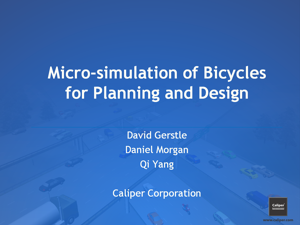


Author: David Gerstle, Daniel Morgan, and Qi Yang
Abstract:
Among the many barriers to projects that improve infrastructure for bicyclists, two of the most onerous are political will and tight budgets, and the tight budgets hold increasing sway over political will. Additionally, emphasis on livable cities and sustainable development in the planning community has given rise to increasing attention to the treatments of alternative modes of travel in planning model applications. Robust micro-simulation models are the answer to the problem of bridging the gap between "soft" objectives like livability and the "hard" objective demonstrating that a bicycling infrastructure project has a quantifiable, fiscally-justifiable positive impact on the surrounding community – pedestrians, cyclists, transit riders, and motorists alike.
Cyclists are difficult to capture in conventional models because they often share the rights of way with but behave entirely differently from motorized vehicles. For example, bicyclists typically have shallower speed and acceleration profiles, are more agile, and follow entirely different rules for what a "lane" is (Faghri and Egyhaziova 1999). For these reasons and more, the intertwined relationships between cyclists and motorists and the relationship between each other’s travel times are unique and complex (Lee, Polak and Bell 2009). Planning models are too course to capture these relationships, and, historically, traffic simulation models have not faithfully captured these relationships of crude, simplistic treatment of cyclists as a small, low-power vehicles. In this paper, we present a new model that extends microscopic traffic simulation to accurately reproduce the phenomena that comprise cyclist behavior.
In short, our model introduces enables cyclists to wholly abandon the single-file car-following behavior that is assumed of cars, trucks, and buses. Cyclists are move laterally in continuous space within and between lanes, while motorized vehicles are simulated with traditional car-following and lane changing models. Cyclists are also allowed to pass one another, and motor vehicles will pass a bicycle in its lane with care. The algorithm can also be extended to motorcyclists, which in some environments exhibit some of the same behaviors as cyclists with respect to acceleration and lateral movements. In the model, cyclists and motorcyclists are sensitive to the speeds and sizes of the vehicles around them which capture a cyclist’s relative comfort with passing different vehicles at different speeds.
We present the model’s behavioral premise and properties and demonstrate its value for visualization and analysis when evaluating projects. We demonstrate some of the statistics that can be used to quantify the value of bicycle infrastructure projects.

Keywords: Microsimulation, Traffic Impact Analysis, Bicycle
References:
Faghri, A and Egyhaziova, E. Development of a Computer
Simulation Model of Mixed Motor Vehicle and Bicycle Traffic on
an Urban Road Network. Transportation Research Record: Safety
and Human Performance, vol. 1674 1999. pp 86-93.
Lee, Tzu-Chang; Polak, John; and Bell, Michael. A New Approach to Modelling Mixed Traffic ContainingMotorcycles in Urban Area. 88th Annual Meeting of the Transportation Research Board, 11th – 15th January 2009, Washington, D.C.
Home | Products | Contact | Secure Store